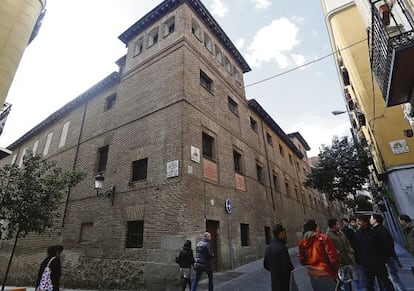The remains of Cervantes?
A male body buried underneath an altar in Madrid may belong to the great novelist

Four centuries after Spain's literary giant Miguel de Cervantes Saavedra died in poverty, Madrid officials will soon embark on an exhaustive search for his grave.
The regional government has given the go-ahead for City Hall to hire a team of experts who will exhume the bones of an adult male buried inside the Trinitarias convent, in the capital's Las Letras neighborhood. The novelist was buried somewhere inside the convent on April 23, 1616.
In the coming days, experts will search the old cloistered nuns' convent with the help of a ground-penetrating radar, also known as a georadar, which picks up and measures underground cavities though pulses of waves.
Since 1870, evidence has been found suggesting that there are undiscovered burial sites beneath the monastery, including one that could be that of an adult man.
The bones of his left hand were crippled after the Battle of Lepanto"
"Under the main altar of the convent's old church, where Mass was celebrated, it is known that there are three people buried there -- a woman, a young child and an adult man," said one City Hall source. This fact has fueled the hypothesis that the male's remains may be those of the great novelist who gave the world Don Quixote.
The body of Miguel de Cervantes, who died at the age of 69, reportedly showed signs of a gunshot wound to his chest from an ancient arquebus weapon. He was wounded during the 1571 Battle of Lepanto while he served in the Spanish navy. "The bones of his left hand were crippled and both sides of his jaw were toothless," the source added.
If the bones match these deformities, they could help support the theory that the remains do indeed belong to Cervantes. But DNA samples would quickly confirm this if any of his descendants can be found to provide a match.
The Madrid region's heritage department will supervise the search, the exhumation and the eventual reburial of the playwright's remains in the same location after the forensic investigation is concluded. Some 12,000 euros have been budgeted for the project.
Under the main altar of the convent's old church, three people are buried there -- a woman, a young child and a man"
The venture got underway in 2011 when a group of researchers, including GDR surveyor Luis Avial and historian Fernando de Prado began petitioning municipal, regional and Catholic Church authorities for permission to conduct a search at the Trinitarias convent. The project was put on hold because of funding issues but after two long meetings in October 2013 and January, all sides gave the go-ahead to begin exploring the ground underneath the convent.
Joining the search will be forensic investigator Francisco Echevarría and his team from the Aranzadi Scientific Society, which has had a certain amount of success in uncovering common graves for different historical memory associations.
Avial, who is expected to return from Argentina, has helped in numerous police investigations in the past. "From the beginning, the project has had the full support of Mayor Ana Botella," said the source from City Hall.
Many people and organizations had underscored the incongruity of Madrid authorities' attitude in failing to make serious scientific efforts to find the remains of such a distinguished author, especially considering that he was buried in a relatively small enclosure and that no evidence exists that he was ever moved from there.
According to historian Fernando de Prado, "there is the added difficulty that a plinth was built to prop up the new Trinitarian church, because of the 12-to-16 degree slope of the ground, and this sealed the underground area of the primitive church that contains the burials."
Yet there are misgivings about the endeavor. Many people still remember the fiasco of 1998, when Gustavo Villapalos, then Madrid's culture commissioner, ordered a search for the remains of the painter Diego Velázquez. Construction work on a parking lot under Plaza de Ramales could have meant the definitive loss of the body, which allegedly lay beneath this square.
The great painter had been buried in 1660 inside the Church of San Juan, near the Royal Palace. This temple was torn down in 1809 on orders of the short-lived monarch Joseph I Bonaparte. Napoleon's brother wanted to clear the area of buildings that might take away from his palace's splendor. That is when the current-day Plaza de Ramales was created.
In theory, Velázquez's remains were still intact under the pavement. Yet this was not the first time that authorities had searched for his body: attempts were made in 1845, 1899, 1942 and 1960.
The new search lasted two years. Archeologists found the pillars of the Church of San Juan — now visible through glass — and many human bones, but none belonging to the creator of Las meninas.
In the end, technicians determined that in 1728, the parish priest of San Juan had all the bodies taken out and the central nave re-floored, thus eliminating any existing gravestone indicating the painter had ever been buried there.







































